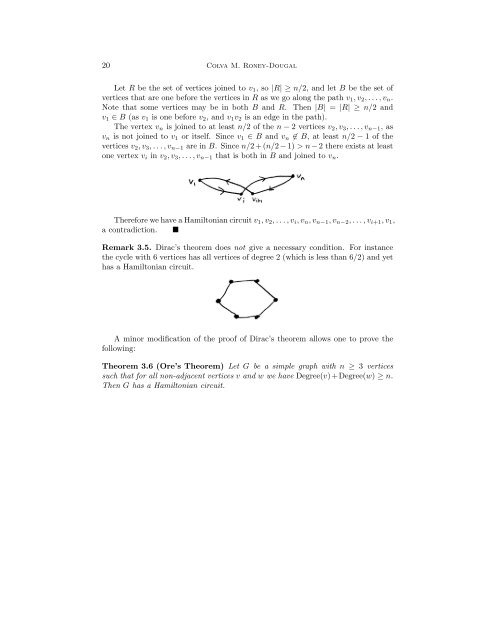Create successful ePaper yourself
Turn your PDF publications into a flip-book with our unique Google optimized e-Paper software.
20 Colva M. Roney-DougalLet R be the set of vertices joined to v 1 , so |R| ≥ n/2, and let B be the set ofvertices that are one before the vertices in R as we go along the path v 1 , v 2 , . . . , v n .Note that some vertices may be in both B and R. Then |B| = |R| ≥ n/2 andv 1 ∈ B (as v 1 is one before v 2 , and v 1 v 2 is an edge in the path).The vertex v n is joined to at least n/2 of the n − 2 vertices v 2 , v 3 , . . . , v n−1 , asv n is not joined to v 1 or itself. Since v 1 ∈ B and v n ∉ B, at least n/2 − 1 of thevertices v 2 , v 3 , . . . , v n−1 are in B. Since n/2 + (n/2 − 1) > n − 2 there exists at leastone vertex v i in v 2 , v 3 , . . . , v n−1 that is both in B and joined to v n .Therefore we have a Hamiltonian circuit v 1 , v 2 , . . . , v i , v n , v n−1 , v n−2 , . . . , v i+1 , v 1 ,a contradiction. Remark 3.5. Dirac’s theorem does not give a necessary condition. For instancethe cycle with 6 vertices has all vertices of degree 2 (which is less than 6/2) and yethas a Hamiltonian circuit.A minor modification of the proof of Dirac’s theorem allows one to prove thefollowing:Theorem 3.6 (Ore’s Theorem) Let G be a simple graph with n ≥ 3 verticessuch that for all non-adjacent vertices v and w we have Degree(v)+Degree(w) ≥ n.Then G has a Hamiltonian circuit.













